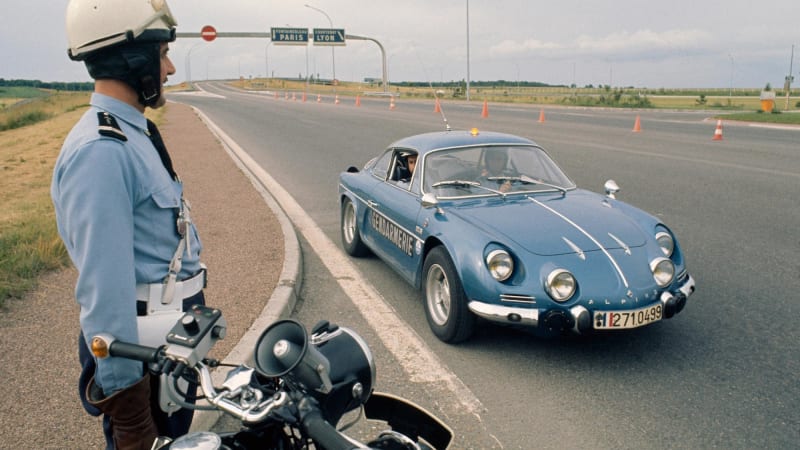Like the original model, the current-generation Alpine A110 has enlisted in the French Gendarmerie. France’s military police ordered 26 examples of the small, lightweight coupe that will be modified to help law enforcement officers catch motorists with a serious need for speed.
Government officials explained that they selected the retro-styled coupe because it’s quick and agile to drive, though the fact that the Gendarmerie has historically used Renault-badged cars for its high-speed operations certainly didn’t hurt Alpine’s chances. Alpine will build the cop cars on the same Dieppe, France, assembly line that manufactures the civilian variant of the A110 (and that made the original model between 1963 and 1977). However, the 26 units will stop by a French outfitter called Durisotti before being deployed on French roads.
There, they’ll receive the modifications required for law enforcement duty. Some of the changes made include Gendarmerie-specific graphics on the body panels, extra lights, sirens, a second touchscreen attached to the dashboard, and a screen mounted behind the rear window that displays instructions (“follow us,” for example). It doesn’t sound like there are any mechanical modifications, meaning power comes from a 1.8-liter four-cylinder engine that’s mid-mounted and tuned to develop 252 horsepower and 236 pound-feet of torque. It spins the rear wheels via a seven-speed dual-clutch automatic transmission (a manual gearbox isn’t available). Hitting 60 mph from a stop takes about 4.3 seconds, and the 2,500-pound coupe’s top speed is electronically limited to 155 mph — luckily, as are a lot of new performance cars.
Renault also offers a 292-horse version of the turbo-four, it’s standard on the A110 S, yet the Gendarmerie settled for the less powerful engine. We’re guessing it’s because the performance gain isn’t as impressive as it might sound. The S is only about a tenth of a second quicker to 60 mph, a difference that’s nearly imperceptible in real-life conditions, and its top speed remains pegged at 155 mph.
It sounds like none of the 26 examples ordered will lead a boring life. Some will be assigned to the brigade rapide d’intervention (BRI; high-speed intervention brigade) whose mission is to catch motorists going well over the speed limit. We’re not talking about five-over on a country road; we mean 150 mph between Salon-de-Provence and Lyon. Others will participate in various missions related to traffic or public safety (they may end up in a high-speed chase, for example), and two will be set aside to train new officers assigned to the BRI.
Alpine has started building the 26 cars, and deliveries will start in early 2022. If you visit France next year, don’t say we didn’t warn you.
The blue in blue
France’s Gendarmerie has a long history of using hot-rodded Renault (and Renault-related) models to catch speeders and criminals. Shown above, the original A110 was one of the BRI’s first patrol cars; it roamed French roads in blue livery starting in 1966. It passed the torch to the A310, its intended successor, in 1973. The Gendarmerie then purchased a series of Renault cars including the 18 Turbo, the 21 Turbo, and the Mégane IDE. The department’s current fleet includes several examples of the Mégane RS, a hot hatch with up to 300 horsepower.
Renault doesn’t have a monopoly on BRI orders, however. The list of cars previously used by the department also includes the Matra Djet (which was replaced by the A110), the Maserati-powered Citroën SM, the Peugeot 405 T16, and, more recently, the Subaru WRX.

